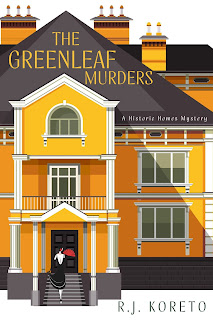R.J. Koreto’s fascination with the Edwardian era has led him to write two historical mystery series: The Lady Frances Ffolkes Series and the Alice Roosevelt Series. He’s now turned his attention to the residences of the past with his Historic Homes Mystery Series. Learn more about him and his books at his website.
Federal Room
My protagonist/sleuth, architect Wren Fontaine, is happiest when she's busy renovating the historic homes she specializes in. Of course, it's not just about the homes—the furniture, and the clothing of the owners, must be coordinated.
Take the Federal style. This was during the "Pride & Prejudice" era, and simplicity was the order of the day. Wren knows her history: Europe was taking a fresh look at the beauty of ancient Roman design, and the French Revolution had made conspicuous consumption unfashionable—and unwise. The beauty of the Federal style came from the perfection of the proportions, the cleanliness of the lines--a surprisingly modern look.
Clothes went along with this. First Lady Dolley Madison was a standard setter in fashion, but her dresses are marked by the elegance of the tailoring, not elaborate festoons of silk. She had a style that befitted the American ideal of egalitarianism.
Jump ahead a century to the Gilded Age. Wren is working on one of the great mansions of the "Upstairs, Downstairs" era. The world had moved on—a new generation of robber barons had made a LOT of money and wanted homes that were practically palaces, from which they could "rule." Elaborate displays of wealth were the order of the day, and Wren concerns herself with the ornate furniture and fixtures that showed the world just how powerful these families were. Costly fabrics and woods, and extravagant designs, were essential, and skilled artisans were practically guaranteed full employment.
And the clothes matched! Women's dresses have rarely been so elaborate before or since, and the wealthy employed an army of maids to help them change clothes several times a day. Indeed, houses now sported special small rooms just for storing clothes, called "closets." Until the mid-19th century, even the wealthy didn't own enough clothing to make this necessary.
In a future book, Wren is going to turn to modernist homes—the post-war "Mad Men" era. We're back to a plainer style—but deceptively so, as there was a lot of philosophy behind this simplicity, such as "form follows function." That is, "purpose" took precedence over "beauty," but the move to exciting new materials lent these homes a beauty all their own. Architects became concerned with how homes were furnished and worked closely with designers.
Here is a modernist room with the famed Eames recliner, designed by Charles and Ray Eames. They worked closely with leading modernist architect Eero Saarinen—indeed, Saarinen named his son "Eames" after them!
Once again, clothes worked in harmony with homes. Have a look at the dresses Betty Draper wore in "Mad Men"—elegant but not overwhelming, they neatly complemented the bright and shiny new aesthetic. And Don Draper made have started with a suburban look, but when he moved into Manhattan, he connects with a cool 1960s vibe.
Even now, architects and furniture and clothing designers are creating the next big thing. What will it be?
The Greenleaf Murders
A Historic Homes Mystery, Book 1
Young architect Wren Fontaine lands her dream job: restoring Greenleaf House, New York's finest Gilded-Age mansion, to its glory days. But old homes have old secrets: Stephen Greenleaf—heir to what’s left of his family’s legacy—refuses to reveal what his plans are once the renovation is completed. And still living in a corner of the home is Stephen's 90-year-old Aunt Agnes who's lost in the past, brooding over a long-forgotten scandal while watching Wren with mistrust.
Wren's job becomes more complex when a shady developer who was trying to acquire Greenleaf House is found murdered. And after breaking into a sealed attic, Wren finds a skeleton stuffed in a trunk. She soon realizes the two deaths, a century apart, are strangely related. Meanwhile, a distraction of a different kind appears in the form of her client's niece, the beautiful and seductive Hadley Vanderwerf. As Wren gingerly approaches a romance, she finds that Hadley has her own secrets.
Then a third murder occurs, and the introverted architect is forced to think about people, and about how ill-fated love affairs and obsessions continue to haunt the Greenleafs. In the end, Wren risks her own life to uncover a pair of murderers, separated by a century but connected by motive. She reveals an odd twist in the family tree that forever changes the lives of the Greenleafs, the people who served them, the mansion they all called home—and even Wren herself.
Buy Links




No comments:
Post a Comment